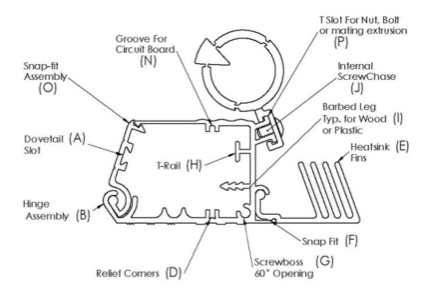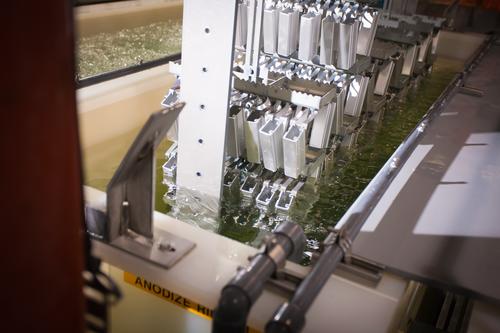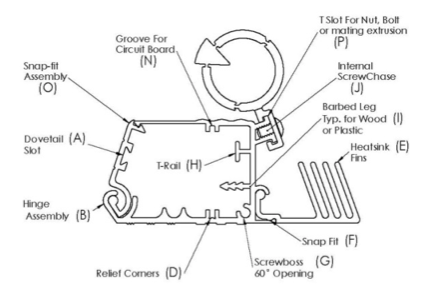Aluminum Extrusion Increases Options to Optimize the Supply Chain, Part 2
May 14, 2015

Editor's Note: This is Part 2 of a feature looking at supplier-based, added-value services that are adjacent to aluminum extrusion production. Part 1 evaluated supplier-provided design and engineering, bending and stretch forming, and precision machining/fabrication.
Extruded aluminum continues to gain traction as a mainstream OEM choice for designing, engineering, and producing component parts. The alloy and the technique have marched aggressively through the awareness and understanding phases and are now solidly in adoption territory. Frequently, aluminum extrusion is an institutionalized supply chain strategy for optimizing design and engineering, reducing manufacturing costs, and accelerating time to market.
A 360-degree view of manufacturing takes into consideration multiple, vendor-supplied services and operations that an OEM can integrate to upgrade the supply chain interaction from a basic buyer-vendor transaction to a collaboration involving strategic, single-source solutions. These operations are as follows:


Chemical Finishing
The chemical finishing method selected for an extruded aluminum component plays a critical role in specifications that drive performance on requirements ranging from aesthetics and protection to maintenance following installation.
Aluminum anodizing produces one of the most common and durable chemical finishes for protecting alloys from atmospheric attack. Essentially, it thickens the protective surface layer of aluminum oxide film -- only millionths of an inch thick -- naturally created when aluminum contacts oxygen. Common anodized applications include components used in building products, appliances, food preparation equipment, home and office furniture, sporting goods, electronics, marine and recreation products, and electro-medical devices.
Etching is a universal preparatory step used prior to anodizing. Almost all anodized product will receive some length of etch, particularly if the design specifies an improved aesthetic value. The process, which breaks up the surface uniformly, creates a more consistent finish that reduces some glare and reflectivity. Common applications include flagpoles, medical device products, durable medical equipment, and light-sensing equipment.
The bright dip process achieves a highly reflective, mirror-like finish by applying an acidic solution to remove metal. To protect the smooth surface and to present a variety of colors, anodizing usually follows bright dipping. Common applications for a bright-dipped and anodized surface include decorative trims, light frames, shower doors, and reflectors.
Assembly
Optimizing the supply chain is not only about early collaboration on manufacturability design and engineering or making the actual extrusion run smoothly. Assembly is integral to a strategy that creates supply-chain-improving opportunities in how components are handled downstream from manufacturing operations.
The same expertise developed and refined through supplier involvement with application-specific solutions also influences effectiveness in converting components into finished assemblies.
Aluminum extrusion's greater efficiency results from producing components that can be joined together without follow-on machining or fabricating. One of the multiple ways extrusions can be joined or fastened without machining involves designing an attachment method into the part profile. For example, instead of machining the bevel for a weld, or a recess for sheet metal, the extrusion profile incorporates an attachment feature like a screw chase. This extruded feature will accept self-tapping screws, thereby eliminating drilling and tapping operations.

The aluminum extrusion diagram in Figure 1 shows profile design features that can ease assembly and speed time to market.
A snap-fit assembly joint (O) is self-locking and requires no additional fasteners to hold the joint together.
A single half-moon snap-fit design (F) can replace rolled shapes riveted together, creating high-strength assemblies and eliminating joining costs.
A cross-section hinge joint assembly (B) features ball and socket shapes that allow them to rotate without separating, while eliminating welded assemblies. It is easy to obtain hinge action through 60 to 90 degrees, but hinge joints also can rotate beyond 90 degrees.
Use a "T" slot for a nut, bolt or mating extrusion (P) and internal screw chase (J) to join assemblies.
To join an extrusion to wood or plastic, use a barbed leg (I).
Other downstream, supply chain-improving opportunities for OEMs to consider include the benefits in working with a single-source supplier that offers custom packaging.
Assembly services with custom packaging of aluminum extrusions helps prevent freight damage and reduce shipping costs between suppliers.
Final product assembly in the extrusion manufacturing facility -- like kitting and retail-ready packaging -- saves additional time and money.
By comparison, an aluminum extrusion supplier limited by a single specialty must outsource multiple operations to meet component production requirements or complete assemblies. In addition to profit item stack-up, the additional subcontracting and multiple-vendor coordination causes lead-time stack-up due to vendor capacity and other restraints. OEMs also are subject to process and quality control variation when a project requires multiple, single-specialty suppliers to complete component manufacturing and assembly.
About the Author(s)
You May Also Like





